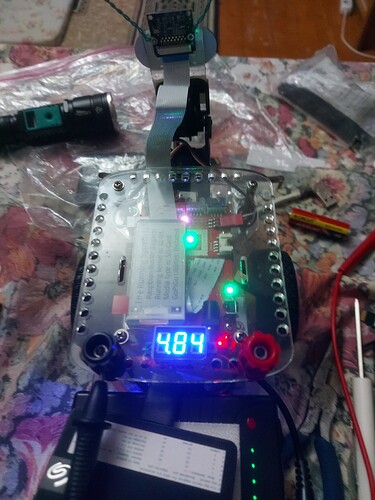One of the problems I’ve been experiencing with my GoPiGo-3 is unexplained “low voltage” alerts when things should be working fine.
Today I finished reassembling Charlie and began my initial research.
What I did:
- I added an on-board voltmeter that is currently connected to the top of the reverse polarity protection diode immediately after the power input USB connector. This was done as a part of the final assembly process so I now have a continuous reading of the Pi’s 5v buss.
-
I verified using an external voltmeter that the voltage I was reading was accurate.
-
I “calibrated” the external 5v boost supply to provide “exactly” 5.00 volts (± 0.02v), with both battery and the adapter connected to a “running” Pi-4 with no operating system present. This was to provide a "fully powered baseline with all power sources attached.
The tests:
Battery only, fully charged, reading at least 12v.:
-
During initial boot the voltage started at about 4.90v, but as the system went through the bootup process the voltage drooped to 4.70v and possibly lower. Since I wasn’t using a 'scope, I could not tell if there were any excursions that were faster than the meter’s approximately 0.5 sec. time constant.
-
I measured at the 5v pins on the top of the GoPiGo’s red-board connector (pins 2 and 4).
- There was no measurable voltage drop between there and the Raspberry Pi’s internal 5v buss.
-
I made the same text between the Raspberry Pi’s 5v pins on the GPIO connector with the same apparent result, regardless of load.
-
Motion of the servos controlling Charlie’s “head” did not cause any voltage changes outside the ± 0.02 tolerance I measured before.
-
Testing with a battery more significantly discharged, (open circuit voltage of about 10.7v), showed a proportional increase in voltage instability at the output of the GoPiGo’s 5v supply - at times dipping as low as 4.5 - 4.6 volts.
Testing with the 5v external supply connected through the USB C power port:
- Repeating all the tests, using both batteries, the 5v buss on the Raspberry Pi never dipped below 5v (± 0.02)
====================
Conclusion:
-
Contact resistance and in-circuit voltage drop was negligible within the tolerances of both the attached voltmeter and my external voltmeter which I used periodically to verify the onboard voltmeter’s readings.
-
I strongly suspect that the GoPiGo’s onboard +5v supply cannot supply the power requirements of it’s own onboard circuitry and a Raspberry Pi-4 without external supplemental power.
Test notes:
-
These tests were done with an"older generation" (26 pin) GoPiGo-3 board.
-
These tests were NOT done with a later generation GoPiGo controller board. At least not yet.

-
These tests were NOT done with an earlier generation Pi, neither were they done with a Pi-5. I suspect, (but cannot prove), that the GoPiGo’s 5v regulator would be more strongly affected by something with the power requirements of a Pi-5.
-
Testing was done using a Seagate “Expansion” 500 gig external SSD attached. Attaching an additional Seagate SSD caused a voltage difference of about 0.10 volts.
More extensive testing remains to be done.
What say ye?
